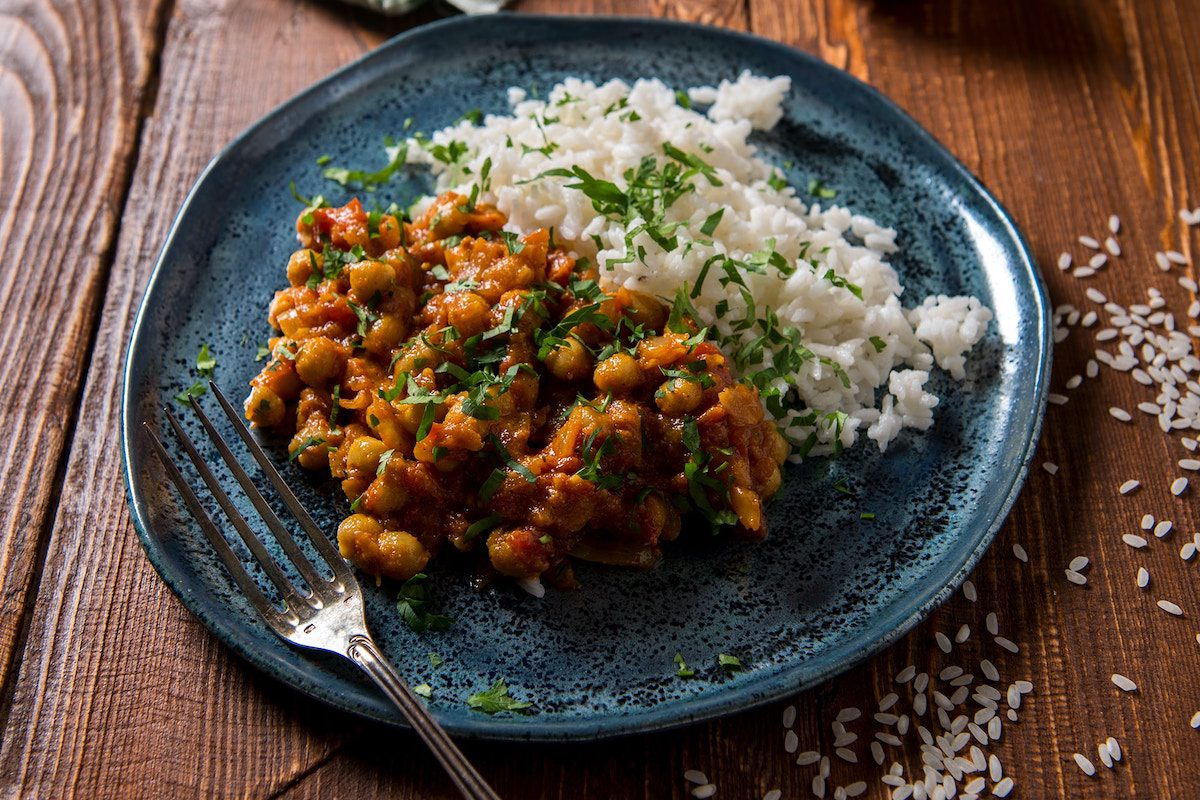How to Incorporate Ayurveda Practices Into Your Life for Better Digestion
It’s no surprise that more and more people are turning to alternative practices to heal what ails them. Ayurveda is the ancient science of aligning diet and lifestyle with the rhythms of nature. It is the world’s oldest continuously practiced wellness system and originated from what is now modern-day India. And because it’s almost cozy-candle-and-sweater-weather, we turned to the pros to learn more about how to incorporate Ayurveda — specifically warming herbs for the fall — into our daily routines to help our bodies.

What is Ayurveda?
France Brunel, founder of the Ayurvedic wellness brand Yoom and a Hatha yoga teacher, says Ayurveda “emphasizes the balance between mind, body, and spirit to promote overall health and well-being and helps people achieve optimal health and well-being by tailoring their diet, supplement intake, and lifestyle practices based on their unique mind-body constitution and very specific physical, mental, and emotional needs.”
She notes that while Ayurveda does make use of herbs and other natural substances for healing purposes, it’s a comprehensive system of medicine that includes lifestyle recommendations, dietary guidelines, and therapeutic practices like massage, yoga, and meditation and many different self-care routines for everyday practice.
“The word Veda means science or wisdom. Ayu means life. The ancient texts describe life as being made up of mind, body, soul, and the senses,” says Angela Perger, an Ayurveda practitioner, holistic health professor, and host of The Simple Ayurveda Podcast.
Perger says Ayurveda teaches you how to flow with nature rather than against it and looks at the root cause of any health ailment or condition, rather than Western medicine which typically treats the symptom.
“I believe that Ayurveda supports healing for everyone,” she says. “That being said, there are times when Ayurveda and Western medicine can work together to create the best possible outcome.”
Perger says there are general guidelines for Ayurveda that apply to everyone, such as the benefits of waking up with the sun, but much of Ayurveda is flexible based on how you’re feeling at any given moment. “When you understand Ayurveda as a system that supports you in living in alignment with nature you see just how adaptable it really is,” she says.
Find your dosha
Brunel says learning your dosha type to help begin your quest into Ayurveda is pretty simple.
“In Ayurvedic medicine, doshas are the energies that make up a person’s body and mind. There are three doshas: Vata (air and ether), Pitta (fire and water), and Kapha (earth and water),” she says. “Each person has a unique combination of these energies that makes up their constitution. By understanding your mind and body type, you can make dietary and lifestyle changes that can help balance your energies and promote optimal health and well-being.”
Perger developed a Modern Day Dosha Quiz to help determine what dosha you are and says the resources from Banyan Botanicals are also excellent.
“Consider learning about the doshas as a lifelong exploration of what makes you feel happier and healthier, knowing that you change as you grow and evolve,” she adds.
Brunel says by understanding your dosha type and aligning to it, you can help a variety of ailments and conditions such as digestive issues, stress and anxiety, skin problems, joint pain, and respiratory problems. “[Ayurveda] also emphasizes preventative care through a healthy lifestyle, including diet, exercise, and stress management,” she says.
What are some easy ways to incorporate Ayurvedic practices for better digestion?
- Chew your food: Perger says Ayurveda focuses heavily on digestion, so with that being said, chewing your food is extremely important as it “supports the breakdown and assimilation of nutrients.”
- Eat mindfully: Another simple practice is mindful eating — doing your best to focus on nothing else (read: no phone) but simply eating during meals.
- Choose cooked over raw foods: Brunel says cooked foods are recommended in Ayurveda over raw since they’re easier to digest, reduce digestive issues, and increase overall energy and mental cognition. Raw foods (although high in nutritional content, she says) are difficult to digest and can disrupt digestion, leading to a buildup of digestive problems.
- Pay attention to cues from your body: Aside from mindful eating and chewing, Ayurveda teaches you to notice how you feel when you eat certain foods, Perger says. For example, if you notice that you’re bloated or having difficulty eliminating, then it may be helpful to think back to the last meal you ate and start to link symptoms with specific foods.
- Create routines: Eat meals at consistent times to help support your digestive system (Perger says it helps to let your body know when to expect nourishment) and get to bed before 10 p.m. for optimal support of cleansing the organs, including the liver.
- Make lunch the biggest meal of the day: Brunel says that’s when your digestive power is at its best, so lunchtime is when you’ll want to ingest the most food. “Keep breakfast and dinner light to promote better sleep,” she says.
- Tongue scrape: Perger says if you do nothing else, get a tongue scraper (“It will change your life!” she says), and Brunel agrees: “Once you scrape, you NEVER go back!”
Start small
Lillian Jacobs, an Ayurvedic health coach who offers 1-on-1 Ayurvedic coaching says it’s not difficult to begin your journey with Ayurveda and people shouldn’t feel overwhelmed by it.
“One of the biggest misconceptions about Ayurveda is that it’s hard to practice,” she says. “There’s a huge arsenal of techniques that Ayurveda uses to bring the body into balance, but you don’t have to do them all to feel the benefits. I find that many people receive a huge list of recommendations from a practitioner or look up a typical Ayurvedic morning routine and become overwhelmed. It’s not an all-or-nothing science and you can use the principles of Ayurveda and make it work for your unique situation and lifestyle.”
How to add more warming herbs into your diet for fall
Perger says for the chilly fall months, eating cooked foods and adding in warming herbs can be easy on your digestion.
“Warm soups are a great way to give your digestive system a break,” she says. “Using ghee and spices are simple ways to incorporate Ayurveda into your cooking. Powdered turmeric, cumin, coriander and fennel are wonderful additions to savory food. Cardamon, cinnamon, and ginger help boost digestion in baked goods or with a warm breakfast like oatmeal.”
Ayurvedic expert Alan Tillotson, PhD, author of The One Earth Herbal Sourcebook, says herbs that are warming help when the body has excess mucus as well as help reduce disturbances to the nervous system, noting black pepper is an excellent addition to your diet.
Jacobs says dinacharya, or Ayurvedic daily rituals, can help maintain balance in the body and can be adjusted based on the seasons — such as fall — and help an individual’s needs.
“Once you’ve honed in on your specific dinacharya, this is a great way to stick to Ayurvedic practices daily,” she says.
Jacobs has also created a free shopping list for each season that you can download on her website. “[It’s] the simplest way is to eat based on the Ayurvedic seasons!” she says.
Bottom line from Perger: “Simple changes practiced consistently create the biggest shift! There’s no need to overhaul your life all at once,” she says. “Start small and let yourself feel the effects.”
Resources and more information on Ayurveda
Perger recommends giving her podcast a listen, The Simple Ayurveda Podcast, where she shares “the good, bad, and most embarrassing parts of living an Ayurvedic lifestyle.” Perger and Jacobs both recommend cookbooks by Kate O’Donnell and Perger loves the book Healing Your Life by Marc Halpern, doctor of chiropractic and Ayurveda practitioner.
Brunel recommends Perger’s podcast as well as books such as The Idiot’s Guide to Ayurveda by Sahara Rose and Ayurveda Cooking for Beginners by Laura Plumb. She also recommends accounts such as @chopra, @my_ayurvedic_life, and @sabrinabawa on Instagram.
Recipe (courtesy of Angela Perger)
Ginger lemon tea
Ingredients:
One inch of fresh ginger sliced
Fresh lemon slices
Optional: honey (see note)
Directions:
Pour boiling water over ginger slices. Allow to sit for 10 minutes. Add fresh lemon juice. Allow to cool slightly before adding honey.
Note: Honey is said to be warming, so, therefore, is recommended as a sweetener in colder weather or if you have a body type that runs cold. Maple syrup is said to be cooling, so it’s recommended in warmer weather or if you have a body type that runs warm.












